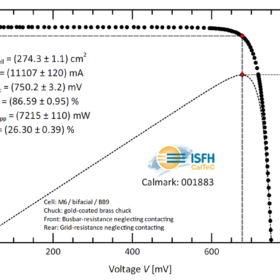Jinergy unveils all-black solar module series for rooftop PV
The all-black series includes a monofacial PERC module with an efficiency of up to 20.86% and an n-type heterojunction product with an efficiency of 21.68%. Both products feature all-black integrated design, with black backsheet, black busbar, black frame and black encapsulant material.
Enel, European Commission sign grant agreement for 3 GW Italian module factory
Enel plans to invest around €600 million in the expansion of its module manufacturing facility in southern Italy. The European Commission will contribute around €118 million to the total sum.
Enel mulls building heterojunction solar module factory in the US
In a recent media brief, new Enel Green Power CEO Salvatore Bernabei said the company’s heterojunction solar module factory in southern Italy will be scaled up from 200MW to 3GW by mid-2024. He also revealed that another factory may be built abroad, with the United States being a possible location.
Longi improves efficiency of its heterojunction cell from 25.82 to 26.30% in just one week
The result was confirmed, once again, by Germany’s Institute for Solar Energy Research Hamelin (ISFH).
TCO-free heterojunction silicon solar cell with 22% efficiency
The cell was built with a phosphorus-doped n-type Czochralski (Cz) silicon wafer with a resistivity of 1.09Ωcm and a thickness of 170mm. Ti/Au/Ag metal stacks were used for the contact with the hydrogenated amorphous silicon (a-Si:H) layers.
Meyer Burger unveils 400 W heterojunction solar module
The solar module will be available in three versions – white, black, and glass-glass. The products have an output of up to 400 W, but when the bifacial effect is optimally used, the output of the glass-glass module can reach up to 430 W. Both the white and black modules weigh less than 20 kg
Meyer Burger buys wafers from different manufacturers
Before the official start of production, the Swiss photovoltaic manufacturer signed contracts with several suppliers that only use polysilicon produced by Wacker Chemie. Meyer Burger plans to start producing its solar modules and cells in Germany in the second quarter.
Silicon heterojunction solar cell hits 23.5% efficiency with new hole-selective contact
Researchers from Switzerland’s École Polytechnique Fédérale de Lausanne have used molybdenum oxide as the hole-selective contact in an heterojuction silicon cell. The scientists claim the compound can compete with traditional contacts despite a lower level of optimization.
Tuesday webinar: New test for microcracks will ‘push the industry to exceed benchmarks’
A new test design from the University of Central Florida has challenged modules with different cell technologies. The results show advantages for the heterojunction modules tested. Here we discuss the new method with its designer.
Meyer Burger abandons plan to relocate operations to China
The Swiss equipment maker is instead preparing to commit its future to PV in its European heartland and will start with plans to help Norwegian module maker REC Solar embark on a gigawatt-scale production expansion.










